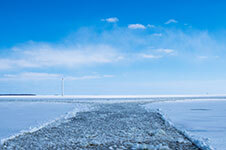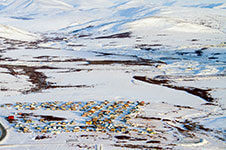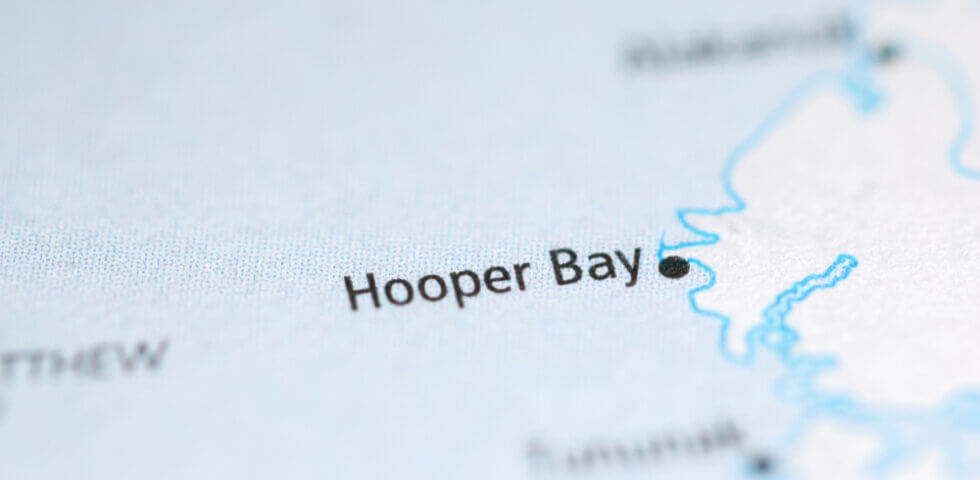Hooper Bay is a small village on the Bering Sea coast with just over 1000 residents. Compared to Anchorage and surrounding areas in Alaska, Hooper Bay is a remote area that is highly underserved when it comes to high-speed internet access. While Quintillion’s fiber optic cable system does not currently serve Hooper Bay, Quintillion is passionate about bridging the digital divide in Alaska and pursuing opportunities to bring fiber to even more communities.
We recently had the opportunity to visit with the Hooper Bay community and speak with representative from multiple schools about internet access in the region and how improved services could benefit the students and the community.
1. Enabling Educators and Students
Poor internet connection severely limits a teacher’s ability to adequately educate and support children in their learning. Additionally, with limited or no access to internet at home, both teachers and students struggle to prepare lesson plans, homework, etc. as the school’s internet may be the only connection they have access to.
When internet connection isn’t provided through fiber, it becomes subject to interference from the weather and other external factors. One Hooper Bay teacher explained that having a strong internet connection would make a significant difference in the classroom, allowing him to create lesson plans, access instructional maters, do PowerPoint presentations, and use videos more easily. He explained that as an instructor, he prefers to use a multimedia approach to learning because children often become more engaged when they have something to see, listen to, or view.
Renee Brown is an instructor at the Hooper Bay Charter School and teaches Cultural Studies to children grades 4-8. She explained that she would often stay at the school for several hours after classes were done to take advantage of the school’s internet access.
She also recalled how difficult distance learning was during the COVID-19 pandemic. Every student was provided with homework packets and teachers would call the students’ homes to set up 15 to 30 minute phone calls with individual students to teach the materials.
Some teachers utilized the Hooper Bay Intranet, a private network that was connected to the school to provide limited access to households with provided antennas and laptops. The Intranet was intended as a temporary solution and could only be used for specific functions, such as broadcasting high school basketball games and allowing students to access teleconferencing technology.
However, navigating distance learning isn’t a problem the schools struggled with only during the pandemic. With extreme weather conditions in Hooper Bay, storms often prevent children from coming to school. Freezing pipes, electrical issues, and other factors related to the weather often require the schools to shut down with no alternatives for home learning.
Renee expressed that reliable internet access would improve education as children can continue their learning and improve overall performance in school. The students’ test scores are noticeably below standards – with many students three or four grade levels behind. Renee feels that improved internet access could have a direct impact on their ability to better research and learn, access resources when they need help with homework, and connect with their teachers and other students when meeting in-person isn’t an option.
2. Obtaining and Sharing Information
In many ways, Hooper Bay is geographically and digitally isolated from the outside world. Without a constant internet connection, the community struggles to keep up with what’s happening in the world – especially in regards to the weather, incoming food supplies, and other factors that impact the community directly.
Britanny, the assistant principal at Hooper Bay School, recalled two especially bad winters where the cell tower in Hooper Bay froze over. She said, “for a month straight I couldn’t call my family, didn’t’ know what was going on in the world, had no idea. Because it all just froze… It was a block of ice.” Without diverse, reliable internet options, with one unavoidable weather event, the entire community was left without a means to communicate in or out for months at a time.
She also explained how difficult it can be for teachers and staff to handle frequent internet disconnection during the school day, especially as so much information, including textbooks and training materials, have moved online. “The equipment we have is not designed for 500 people to all be on at once.” Through the day, she frequently hears reports of, “The internet’s too slow. My computer won’t connect. Access point went down. The pages won’t load. The internet popped off.”
In addition to difficulties accessing information, Hooper Bay has few outlets to communicate and share with the outside world. One teacher at a Hooper Bay school moved from the Philippines in 2022 to teach children math, science, and reading, and he explained how difficult it was to find the information he needed to prepare for life in Hooper Bay. It wasn’t until he landed in Anchorage, he learned that he needed to buy a good pair of boots, ice cleats, and the thickest coast available to prepare for the extreme weather conditions ahead of him.
3. Accessing Vital Healthcare Services
Poor access to healthcare services is a major concern in Hooper Bay, and many other remote locations in Alaska. Britanny explained that their clinic is “critically understaffed,” and that they had multiple days in the last month where it’s only been open for “life and limb.”
The clinic is open 24/7, seven day a week, and they also serve patients in some of the neighboring communities around Hooper Bay. The clinic’s coordinator explains that the internet is very important for connecting people with more services if needed, performing online trainings, and teleconferences. Clinic employees often take turns during their shift utilizing the internet. However, there have been times where the clinic hasn’t had access to this vital connection for days.
Telehealth would have a significant impact on access for the Hooper Bay community, as residents could access services such as counseling or primary care visits with a provider outside the area. Online doctor visits would also make it easier for residents to speak with a specialist.
4. Getting Supplies Outside Hooper Bay
Hooper Bay is very limited in where residents can purchase groceries, household items, and many other products. There is one store where people can purchase most items, and many people don’t have the option to shop online if the items they need are too expensive or not in stock. One resident commented on how expensive it can be to live in Hooper Bay, and that he had paid $40 for five dozen eggs that morning.
Britanny stated, for Hooper Bay, internet is really a lifeline for people. Getting plane tickets in and out, getting goods and services, accessing family that have moved out. The times that we’ve had internet go down, you really notice just how much life is impacted here.”
5. Exploring School and Career Opportunities
Poor internet access does not only impact performance and opportunities for school-aged students. New graduates and young adults are similarly impacted by not having access to a strong internet connection at home. Jean Armstrong, a school counselor at a K-12 school in Hooper Bay, explains that most of the high school students he works with use the school’s internet to fill out FASFA, work on other scholarships, and job applications.
He also mentioned that “most high school seniors aren’t thinking about college yet. Most of the counseling that I do…is with the young adults who had graduated maybe two, three, four years before.” He explains that it’s at this point many students feel driven to pursue an education, trainings, or a new job opportunity. And that they need to have access to apply for a new job or fill out an online college application.”
Connecting Hooper Bay to the World: Quintillion’s Hooper Bay- Emmonak project
Quintillion proposes to build a subsea fiber extension of its existing middle mile fiber network from Nome to the Native Villages of Emmonak and Hooper Bay, then last mile fiber to the premises (FTTP) delivering 100 Mbps or greater symmetric broadband services to all premises in the two unserved communities, serving a total population of 2,238 comprising 501 households and some 50 businesses, 3 schools, and 2 medical clinics covering a total service area of 13.38 square miles. This will deliver fast affordable high-speed broadband service to these communities for the first time including low-cost packages that are sufficient and practical.
Broadband service availability will be life changing and lifesaving to the residents, and transformational to the institutions in these currently unserved and underserved communities.
The Hooper Bay community is incredibly skilled and resilient, and the community has always actively sought opportunities to support its students and its residents. However, without a reliable and permanent internet solution, children and adults are greatly disadvantaged in the opportunities they can pursue. Quintillion’s mission is to continue supporting Alaska in achieving a more connected world for Alaskans in every village.
Want to learn more Quintillion’s subsea fiber optic cable system and how it’s bringing the gold standard of connectivity to the Alaska Arctic? Contact our team to get in touch or read the Quintillion blog to stay on top of the latest industry news.















